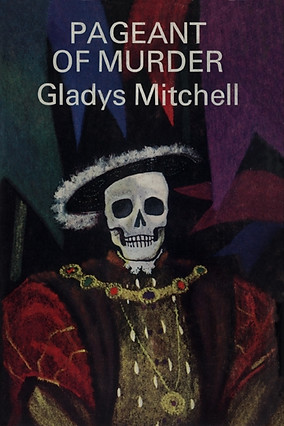PAGEANT OF MURDER (1965)
1965 Michael Joseph. Reprinted 1965 London House (U.S.); 1984 Severn House; 1985 Chivers Large Print.
"What have you been up to?" enquired Laura, when the maid had had instructions to show the officer into the drawing-room. "Parking offence, bouncing through the red lights, tossing rubbish into the reservoir, trying to blow up the gasworks?"
"Oh, dry up, Dog," said Kitty. "It will be something about that wretched little man."
"What wretched little man?"
"Falstaff. I bet he's got himself run over in Brayne high street or something. I had the stage-manager on the telephone this morning to say he hadn't been traced. Well, now I suppose he has finished up in hospital."
"Why should they worry you about it?"
"Oh, Dog, because they've worried everybody else first, I suppose, and got nowhere."
This was not a bad guess, as matters turned out.

The humble town of Brayne is about to be upgraded to a borough. For energetic councilor Julian Perse such elevated status requires proper celebration, namely the organization of a multi-part historical pageant to be held throughout the village. A parade of figures—including Henry VIII with six wives in tow and Edward III—will entertain the crowd in the high street, building to an evening performance of dancers, tumblers, comedians, children’s choir, and selections from The Merry Wives of Windsor at the town (now borough) hall. To pull all these elements together and essentially stage-manage the spectacle, Julian presses into service his aunt, successful fashion writer Kitty Trevelyan-Twigg. Reluctant but unwilling to let her nephew down, Kitty lends her services; first, though, she consults her old Carteret College friend Laura Menzies, who looks on in amused interest.
The day arrives and the pageant looks to be a success, despite concerns over early morning rain and, later, a donkey joining the squire’s horse on the field during a stately display of dressage. At the town hall, the jokes of the hired comedy act are not blue but merely stale, the children remain under control, and Falstaff is speedily removed in Windsor’s washing basket. When the actor fails to appear for his second scene, however, Kitty is forced to usher in the night’s next performance. Falstaff reappears by the river, the basket nearby and a fatal knife wound in his side. An agitated Kitty reports to Laura, who in turn tells her employer, Dame Beatrice Bradley. It’s just as well that the aged psychoanalyst is brought in: the actor playing Henry VIII soon disappears, and his costumed body is found—minus the head—in a wooded lane.
Despite these perceived curses (and against Kitty’s wishes), Julian Perse decides to mount a sequel to the star-crossed pageant, this one much less publicized and without the town’s formal blessing. A re-enactment of an eighteenth century election ends in a modern-day gang fight, and the following morning finds the unfortunate Edward III swinging from the Hangman’s Oak tree. A hunch leads Laura to the discovery of Henry’s head, while Dame Beatrice works with the police to unmask the culprit and put a stop to these historically-themed murders.
Pageant of Murder displays Gladys Mitchell’s later-career weaknesses: she keeps her principal players offstage — the three victims are more often identified by their historical personas, and the suspects are more often spoken about than spotted — and her dialogue bends to dialectic. In fact, the book’s weaker second half principally records discussions between Dame Beatrice and someone designated as information gatherer or sounding board (alternately Laura, Kitty, and Laura’s inspector husband, Robert Gavin). Even with these flaws, Mitchell still manages to deliver a story that generally sticks together and, especially in its early chapters, breezily entertains.
There is a run of high-spiritedness and comic description that, while not reaching the heights of her great works like The Mystery of a Butcher’s Shop and The Saltmarsh Murders, made this Pageant more agreeable to revisit a second time around. Details surrounding the celebration become more compelling than the mystery plot itself, thanks to the author's vivid writing. An example:
"The afternoon remained fine. There were moments of tension, it was true, as when some of the maypole dancers went wrong in reverse, but their teachers, wading waist-deep into the holocaust, soon pushed and prodded the thing to rights, and the primary schools trotted off, amid applause, to be regaled with lemonade and buns in a large marquee which had been set up in the paddock…"
Many principal characters don't receive the same kind of attention, which is a bit disappointing. Gladys Mitchell doesn't even christen Kitty Trevelyan's husband with a first name; he is referred to simply as "Twigg." Taken in all, Pageant of Murder isn't a bad entry in the series, only a weak one. It contains enough of the author's charms and flourishes to offset the fact that the parade in view is rather haphazardly assembled.